Black Devils in Normandy—Identification of an Unknown Soldier Found in the Polish War Cemetery of Urville-Langannerie (France)
Abstract
1. Introduction
Purpose of the Work
2. Material and Methods
3. Anthropological Methods
3.1. Biological Profile Methodology
3.2. Genetic Methods
3.2.1. DNA Extraction
3.2.2. DNA Concentration Measurement and Inhibition Evaluation
3.2.3. STR Amplification and Product Detection
3.2.4. mtDNA Analysis
3.2.5. Kinship Testing
4. Results
4.1. Anthropological Results
4.2. Genetic Testing Results
5. Discussion
Author Contributions
Funding
Informed Consent Statement
Data Availability Statement
Conflicts of Interest
References and Note
- McGilvray, E. Black Devils’ March—A Doomed Odyssey: The 1st Polish Armoured Division 1939–1945; Helion and Company: Warwick, UK, 2005. [Google Scholar]
- Cunningham, C.; Scheuer, L.; Black, S. Developmental Juvenile Osteology, 1st ed.; Elsevier: San Diego, CA, USA, 2000; ISBN 9780126240009. [Google Scholar]
- Lovejoy, C.O.; Meindl, R.S.; Pryzbeck, T.R.; Mensforth, R.P. Chronological metamorphosis of the auricular surface of the ilium: A new method for the determination of adult skeletal age at death. Am. J. Phys. Anthropol. 1985, 68, 15–28. [Google Scholar] [CrossRef] [PubMed]
- van Oven, M.; Kayser, M. Updated comprehensive phylogenetic tree of global human mitochondrial DNA variation. Hum. Mutat. 2009, 30, E386–E394. [Google Scholar] [CrossRef] [PubMed]
- Lovejoy, C.O. Dental wear in the Libben population: Its functional pattern and role in the determination of adult skeletal age at death. Am. J. Phys. Anthropol. 1985, 68, 47–56. [Google Scholar] [CrossRef] [PubMed]
- Stewart, T.D. Essentials of Forensic Anthropology—Especially as Developed in the United States; United States of America: Washington, DC, USA, 1979. [Google Scholar]
- Stewart, T.D. Estimation of Stature from Intact Long Bones. In Personal Identification in Mass Disasters; Stewart, T.D., Ed.; Scientific Research Publishing: Washington, DC, USA, 1970. [Google Scholar]
- Kukla-Bartoszek, M.; Szargut, M.; Pośpiech, E.; Diepenbroek, M.; Zielińska, G.; Jarosz, A.; Piniewska-Róg, D.; Arciszewska, J.; Cytacka, S.; Spólnicka, M.; et al. The challenge of predicting human pigmentation traits in degraded bone samples with the MPS-based HIrisPlex-S system. Forensic Sci. Int. Genet. 2020, 47, 102301. [Google Scholar] [CrossRef]
- Barbaro, A.; Cormaci, P.; Falcone, G. Validation of BTATM lysis buffer for DNA extraction from challenged forensic samples. Forensic Sci. Int. Genet. Suppl. Ser. 2011, 3, e61–e62. [Google Scholar] [CrossRef]
- Gouveia, N.; Brito, P.; Serra, A.; Balsa, F.; Andrade, L.; São Bento, M.; Cunha, P.; Bogas, V.; Lopes, V.; Porto, M.J. Validation of Quantifiler ® Trio DNA Quantification kit in forensic samples. Forensic Sci. Int. Genet. Suppl. Ser. 2015, 5, e24–e25. [Google Scholar] [CrossRef]
- Szargut, M.; Diepenbroek, M.; Zielińska, G.; Cytacka, S.; Arciszewska, J.; Jałowińska, K.; Piątek, J.; Ossowski, A. Is MPS always the answer? Use of two PCR-based methods for Y-chromosomal haplotyping in highly and moderately degraded bone material. Forensic Sci. Int. Genet. 2019, 42, 181–189. [Google Scholar]
- SWGDAM Scientific Working Group. Interpretation Guidelines for Mitochondrial DNA Analysis by Forensic DNA Testing Laboratories, Scientific Working Group on DNA Analysis Methods [Internet]. 2018. Available online: https://www.swgdam.org/_files/ugd/4344b0_f61de6abf3b94c52b28139bff600ae98.pdf (accessed on 21 January 2023).
- Ossowski, A.; Piatek, J.; Brzeziński, P.; Zielińska, G.; Parafiniuk, M. Identification of the site of skeletal remains from World War II. Arch. Med. Sadowej Kryminol. 2009, 59, 243–247. [Google Scholar]
- Zielińska, G.; Ossowski, A.; Kuś, M. Examples of exceptional human identifications done by department of forensic genetics in Szczecin, Poland. Forensic Sci. Int. Genet. Suppl. Ser. 2015, 5, e510–e511. [Google Scholar] [CrossRef]
- Kuś, M.; Ossowski, A.; Zielińska, G. Example of genetic identifications of victims of totalitarian regimes in Poland. Forensic Sci. Int. Genet. Suppl. Ser. 2015, 5, e356–e357. [Google Scholar] [CrossRef]
- Ossowski, A.; Kuś, M.; Kupiec, T.; Bykowska, M.; Zielińska, G.; Jasiński, M.E.; March, A.L. The Polish Genetic Database of Victims of Totalitarianisms. Forensic Sci. Int. 2016, 258, 41–49. [Google Scholar] [CrossRef]
- Ossowski, A.; Kuś, M.; Brzeziński, P.; Prüffer, J.; Piątek, J.; Zielińska, G.; Bykowska, M.; Jałowińska, K.; Torgaszev, A.; Skoryukov, A.; et al. Example of human individual identification from World War II gravesite. Forensic Sci. Int. 2013, 233, 179–192. [Google Scholar] [CrossRef] [PubMed]
- Ossowski, A.; Diepenbroek, M.; Kupiec, T.; Bykowska-Witowska, M.; Zielińska, G.; Dembińska, T.; Ciechanowicz, A. Genetic Identification of Communist Crimes’ Victims (1944–1956) Based on the Analysis of One of Many Mass Graves Discovered on the Powazki Military Cemetery in Warsaw, Poland. J. Forensic Sci. 2016, 61, 1450–1455. [Google Scholar] [CrossRef] [PubMed]
- Ossowski, A.; Diepenbroek, M.; Zwolski, M.; Falis, A.; Wróbel, M.; Bykowska-Witowska, M.; Zielińska, G.; Szargut, M.; Kupiec, T. A case study of an unknown mass grave—Hostages killed 70 years ago by a Nazi firing squad identified thanks to genetics. Forensic Sci. Int. 2017, 278, 173–176. [Google Scholar] [CrossRef] [PubMed]
- Diepenbroek, M.; Amory, C.; Niederstätter, H.; Zimmermann, B.; Szargut, M.; Zielińska, G.; Dür, A.; Teul, I.; Mazurek, W.; Persak, K.; et al. Genetic and phylogeographic evidence for Jewish Holocaust victims at the Sobibór death camp. Genome Biol. 2021, 22, 200. [Google Scholar] [CrossRef]
- Marjanović, D.; Hadžić Metjahić, N.; Čakar, J.; Džehverović, M.; Dogan, S.; Ferić, E.; Džijan, S.; Škaro, V.; Projić, P.; Madžar, T.; et al. Identification of human remains from the Second World War mass graves uncovered in Bosnia and Herzegovina. Croat. Med. J. 2015, 56, 257–262. [Google Scholar] [CrossRef]
- Šlaus, M.; Strinović, D.; Pećina-Šlaus, N.; Brkić, H.; Baličević, D.; Petrovečki, V.; Pećina, T.C. Identification and analysis of human remains recovered from wells from the 1991 War in Croatia. Forensic Sci. Int. 2007, 171, 37–43. [Google Scholar] [CrossRef]
- Borić, I.; Ljubković, J.; Sutlović, D. Discovering the 60 years old secret: Identification of the World War II mass grave victims from the island of Daksa near Dubrovnik, Croatia. Croat. Med. J. 2011, 52, 327–335. [Google Scholar] [CrossRef]
- Zupanič Pajnič, I.; Obal, M.; Zupanc, T. Identifying victims of the largest Second World War family massacre in Slovenia. Forensic Sci. Int. 2020, 306, 110056. [Google Scholar] [CrossRef]
- Zupanič Pajnič, I.; Gornjak Pogorelc, B.; Balažic, J. Molecular genetic identification of skeletal remains from the Second World War Konfin I mass grave in Slovenia. Int. J. Legal Med. 2010, 124, 307–317. [Google Scholar] [CrossRef]
- Grochowalski, Ł.; Jarczak, J.; Urbanowicz, M.; Słomka, M.; Szargut, M.; Borówka, P.; Sobalska-Kwapis, M.; Marciniak, B.; Ossowski, A.; Lorkiewicz, W.; et al. Y-Chromosome Genetic Analysis of Modern Polish Population. Front. Genet. 2020, 11, 567309. [Google Scholar] [CrossRef] [PubMed]
- Hofreiter, M.; Sneberger, J.; Pospisek, M.; Vanek, D. Progress in forensic bone DNA analysis: Lessons learned from ancient DNA. Forensic Sci. Int. Genet. 2021, 54, 102538. [Google Scholar] [CrossRef] [PubMed]
- Budowle, B.; Allard, M.W.; Wilson, M.R.; Chakraborty, R. Forensics and Mitochondrial DNA: Applications, Debates, and Foundations. Annu. Rev. Genomics Hum. Genet. 2003, 4, 119–141. [Google Scholar] [CrossRef] [PubMed]
- Holland, M.M.; Fisher, D.L.; Mitchell, L.G.; Rodriquez, W.C.; Canik, J.J.; Merril, C.R.; Weedn, V.W. Mitochondrial DNA sequence analysis of human skeletal remains: Identification of remains from the Vietnam War. J. Forensic Sci. 1993, 38, 542–553. [Google Scholar] [CrossRef]
- Bar, W.; Brinkmann, B.; Budowle, B.; Carracedo, A.; Gill, P.; Holland, M.; Lincoln, P.J.; Mayr, W.; Morling, N.; Olaisen, B.; et al. Guidelines for Mitochondrial DNA Typing. Vox Sang. 2000, 79, 121–125. [Google Scholar] [CrossRef]
- Parson, W.; Brandstätter, A.; Alonso, A.; Brandt, N.; Brinkmann, B.; Carracedo, A.; Corach, D.; Froment, O.; Furac, I.; Grzybowski, T.; et al. The EDNAP mitochondrial DNA population database (EMPOP) collaborative exercises: Organisation, results and perspectives. Forensic Sci. Int. 2004, 139, 215–226. [Google Scholar] [CrossRef]
- Sinha, M.; Rana, M.; Kushwaha, P. Applications of Mitochondrial DNA in Forensic Science. In Forensic DNA Typing: Principles, Applications and Advancements; Springer: Singapore, 2020; pp. 329–343. [Google Scholar]
- Stewart, J.E.B.; Fisher, C.L.; Aagaard, P.J.; Wilson, M.R.; Isenberg, A.R.; Polanskey, D.; Pokorak, E.; DiZinno, J.A.; Budowle, B. Length Variation in HV2 of the Human Mitochondrial DNA Control Region. J. Forensic Sci. 2001, 46, 15059J. [Google Scholar] [CrossRef]
- Ivanov, P.L.; Wadhams, M.J.; Roby, R.K.; Holland, M.M.; Weedn, V.W.; Parsons, T.J. Mitochondrial DNA sequence heteroplasmy in the Grand Duke of Russia Georgij Romanov establishes the authenticity of the remains of Tsar Nicholas II. Nat. Genet. 1996, 12, 417–420. [Google Scholar] [CrossRef]
- Gill, P.; Ivanov, P.L.; Kimpton, C.; Piercy, R.; Benson, N.; Tully, G.; Evett, I.; Hagelberg, E.; Sullivan, K. Identification of the remains of the Romanov family by DNA analysis. Nat. Genet. 1994, 6, 130–135. [Google Scholar] [CrossRef]
- Wilson, M.R.; Polanskey, D.; Replogle, J.; DiZinno, J.A.; Budowle, B. A family exhibiting heteroplasmy in the human mitochondrial DNA control region reveals both somatic mosaicism and pronounced segregation of mitotypes. Hum. Genet. 1997, 100, 167–171. [Google Scholar] [CrossRef]
- Ríos, L.; Ovejero, J.I.C.; Prieto, J.P. Identification process in mass graves from the Spanish Civil War I. Forensic Sci. Int. 2010, 199, e27–e36. [Google Scholar] [CrossRef] [PubMed]
- Baeta, M.; Núñez, C.; Cardoso, S.; Palencia-Madrid, L.; Herrasti, L.; Etxeberria, F.; de Pancorbo, M.M. Digging up the recent Spanish memory: Genetic identification of human remains from mass graves of the Spanish Civil War and posterior dictatorship. Forensic Sci. Int. Genet. 2015, 19, 272–279. [Google Scholar] [CrossRef] [PubMed]
- Piccinini, A.; Coco, S.; Parson, W.; Cattaneo, C.; Gaudio, D.; Barbazza, R.; Galassi, A. World War One Italian and Austrian soldier identification project: DNA results of the first case. Forensic Sci. Int. Genet. 2010, 4, 329–333. [Google Scholar] [CrossRef]
- Ministry of Defence UK. Polish Section. Personal documents of Uhlan Michał Mosur, Registration card.
- Amorim, A.; Fernandes, T.; Taveira, N. Mitochondrial DNA in human identification: A review. PeerJ 2019, 7, e7314. [Google Scholar] [CrossRef] [PubMed]
- Definis Gojanović, M.; Sutlović, D. Skeletal remains from World War II mass grave: From discovery to identification. Croat. Med. J. 2007, 48, 520–527. [Google Scholar] [PubMed]
- Rainio, J.; Hedman, M.; Karkola, K.; Lalu, K.; Peltola, P.; Ranta, H.; Sajantila, A.; Söderholm, N.; Penttilä, A. Forensic osteological investigations in Kosovo. Forensic Sci. Int. 2001, 121, 166–173. [Google Scholar] [CrossRef] [PubMed]
- Andelinović, S.; Sutlović, D.; Erceg Ivkosić, I.; Skaro, V.; Ivkosić, A.; Paić, F.; Rezić, B.; Definis-Gojanović, M.; Primorac, D. Twelve-year experience in identification of skeletal remains from mass graves. Croat. Med. J. 2005, 46, 530–539. [Google Scholar]
- Westen, A.A.; Gerretsen, R.R.R.; Maat, G.J.R. Femur, rib, and tooth sample collection for DNA analysis in disaster victim identification (DVI). Forensic Sci. Med. Pathol. 2008, 4, 15–21. [Google Scholar] [CrossRef]
- Iwamura, E.S.M.; Soares-Vieira, J.A.; Muñoz, D.R. Human identification and analysis of DNA in bones. Rev. Hosp. Clin. Fac. Med. Sao. Paulo. 2004, 59, 383–388. [Google Scholar] [CrossRef]
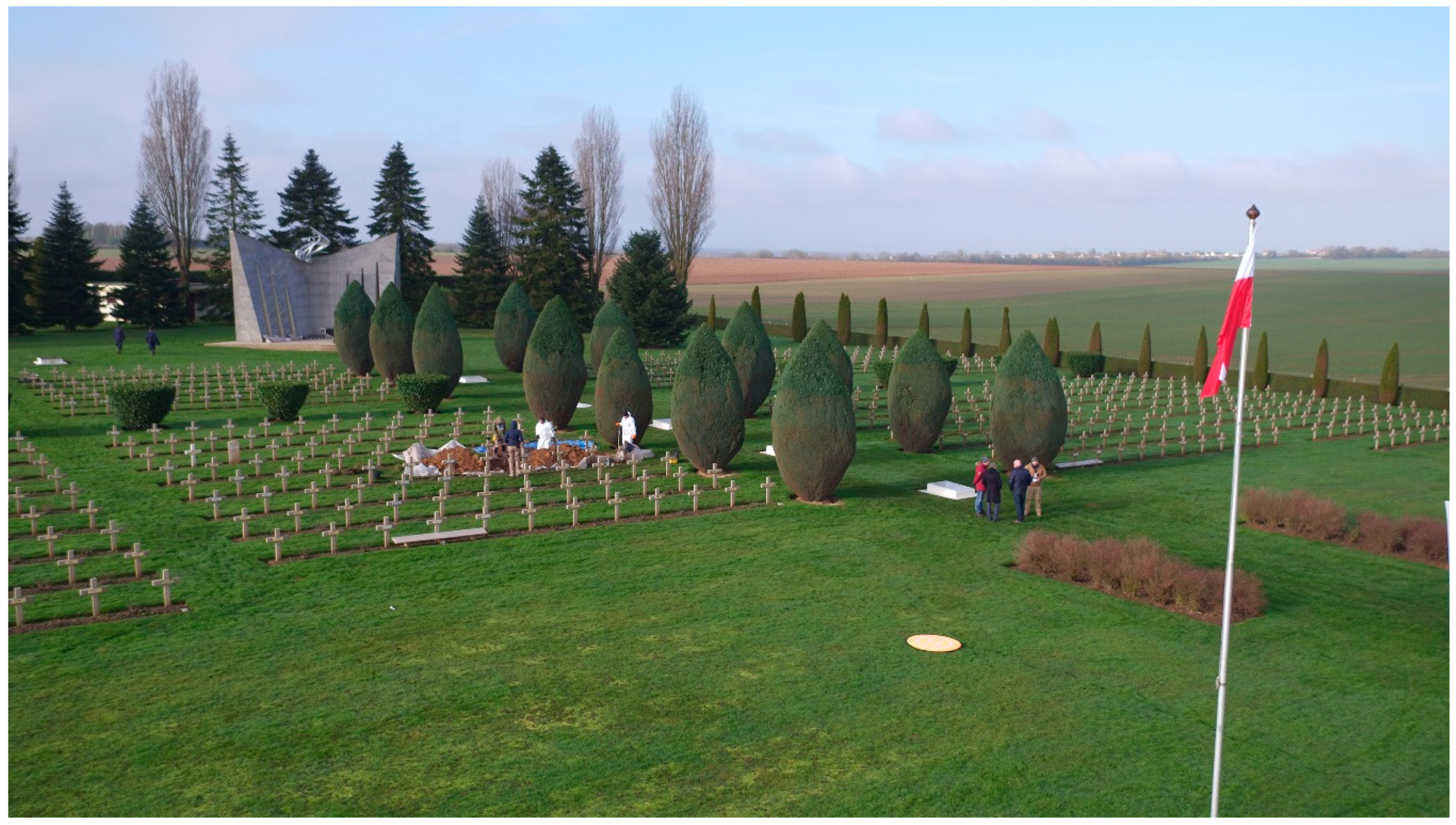
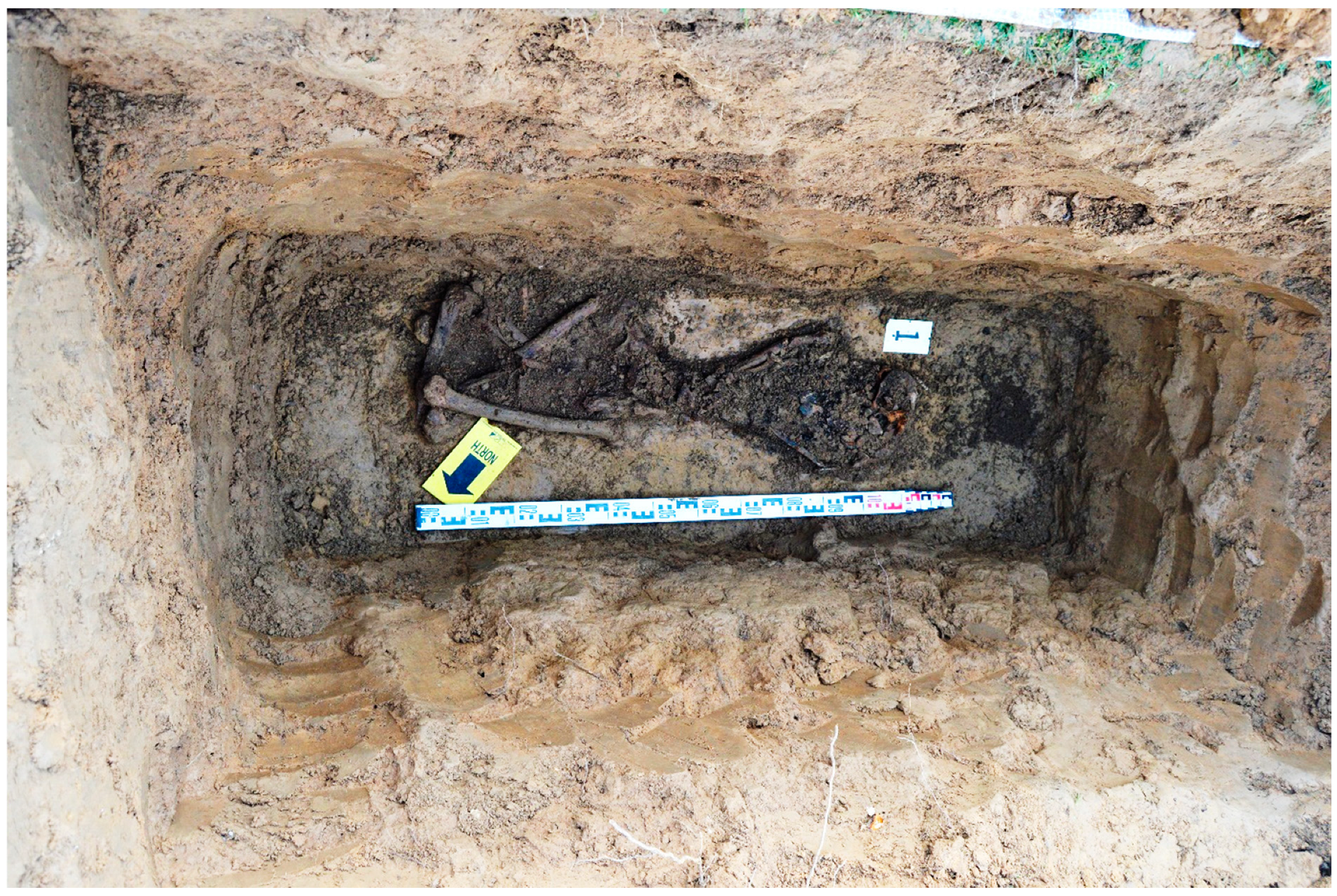
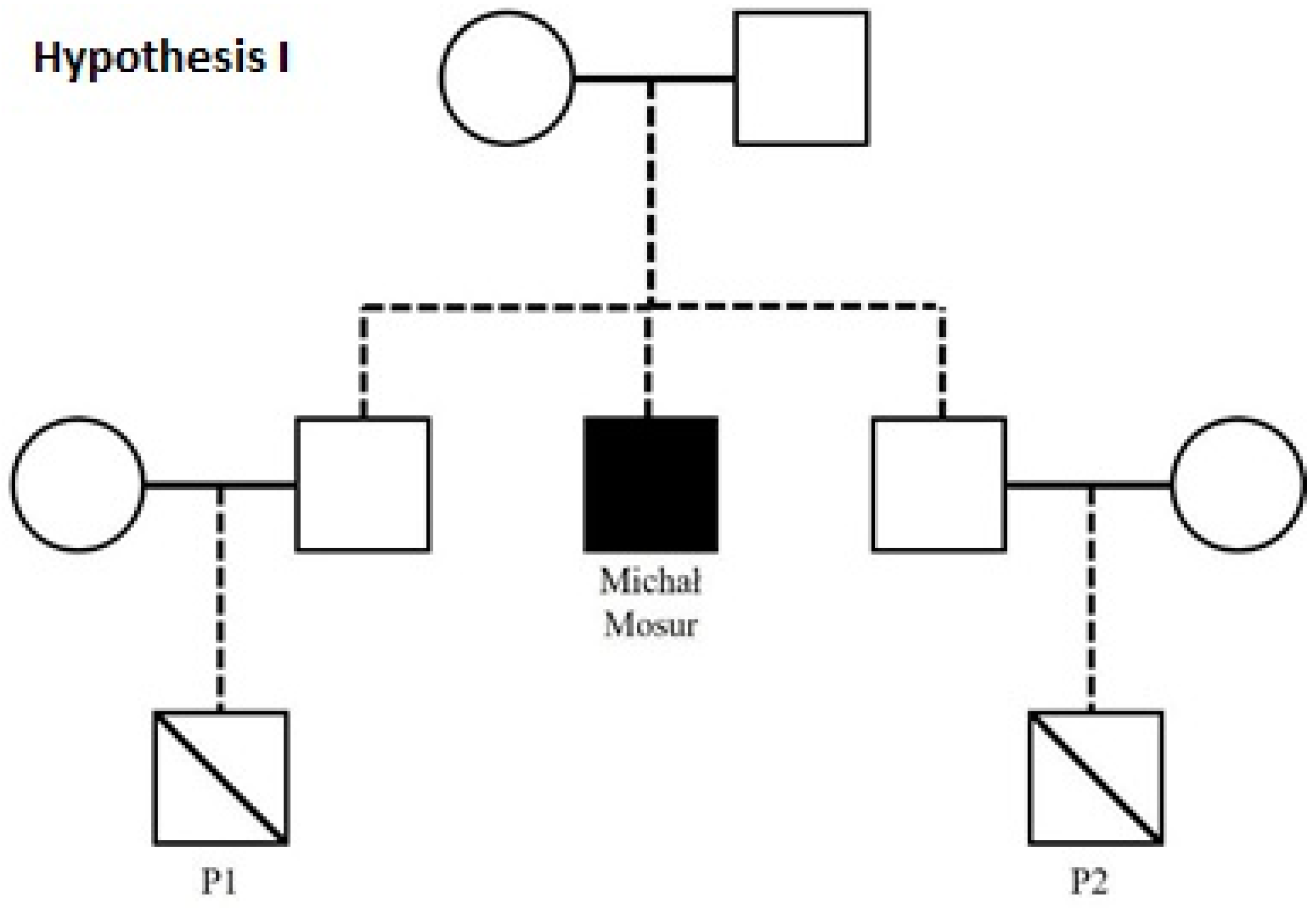
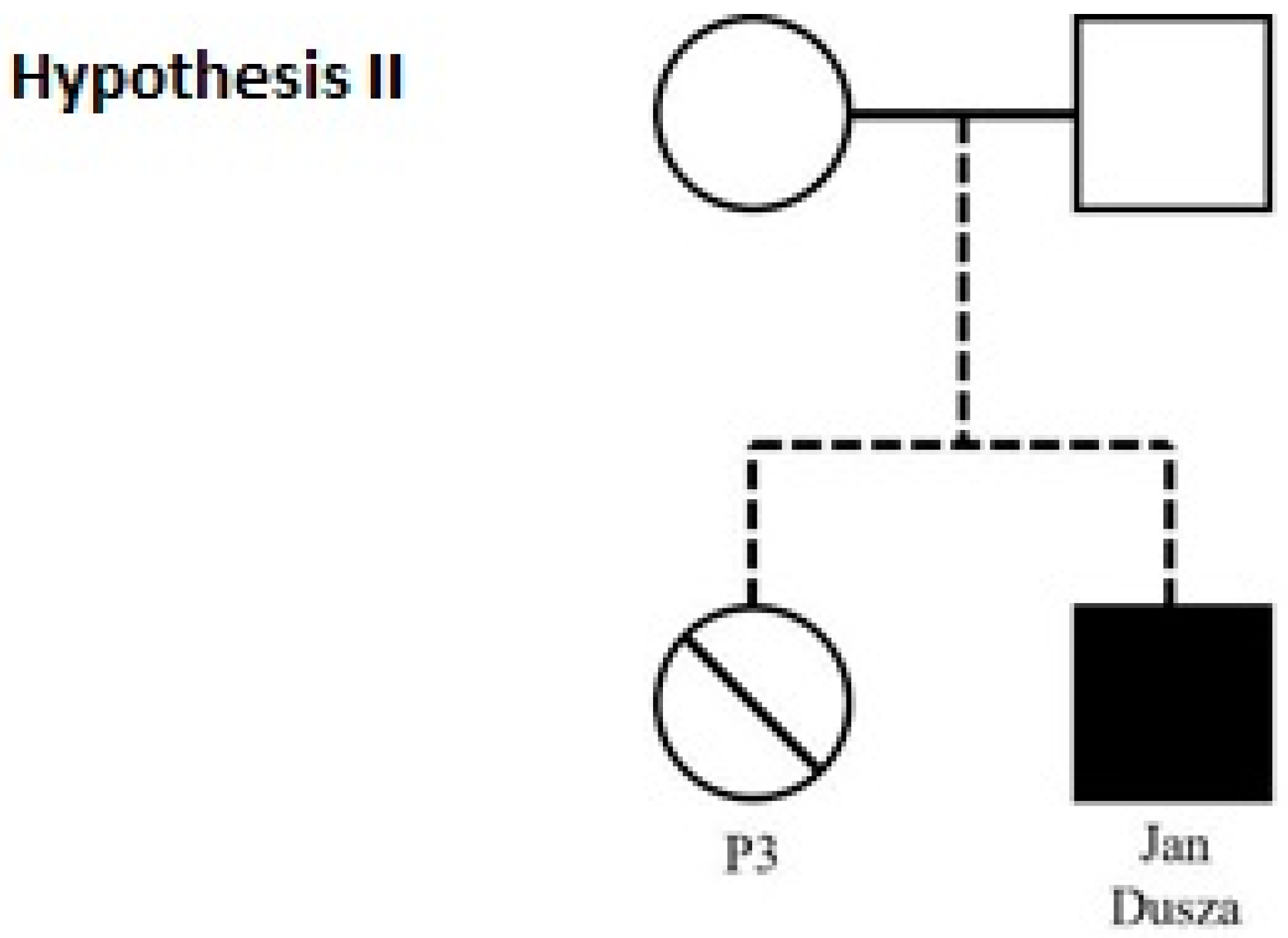
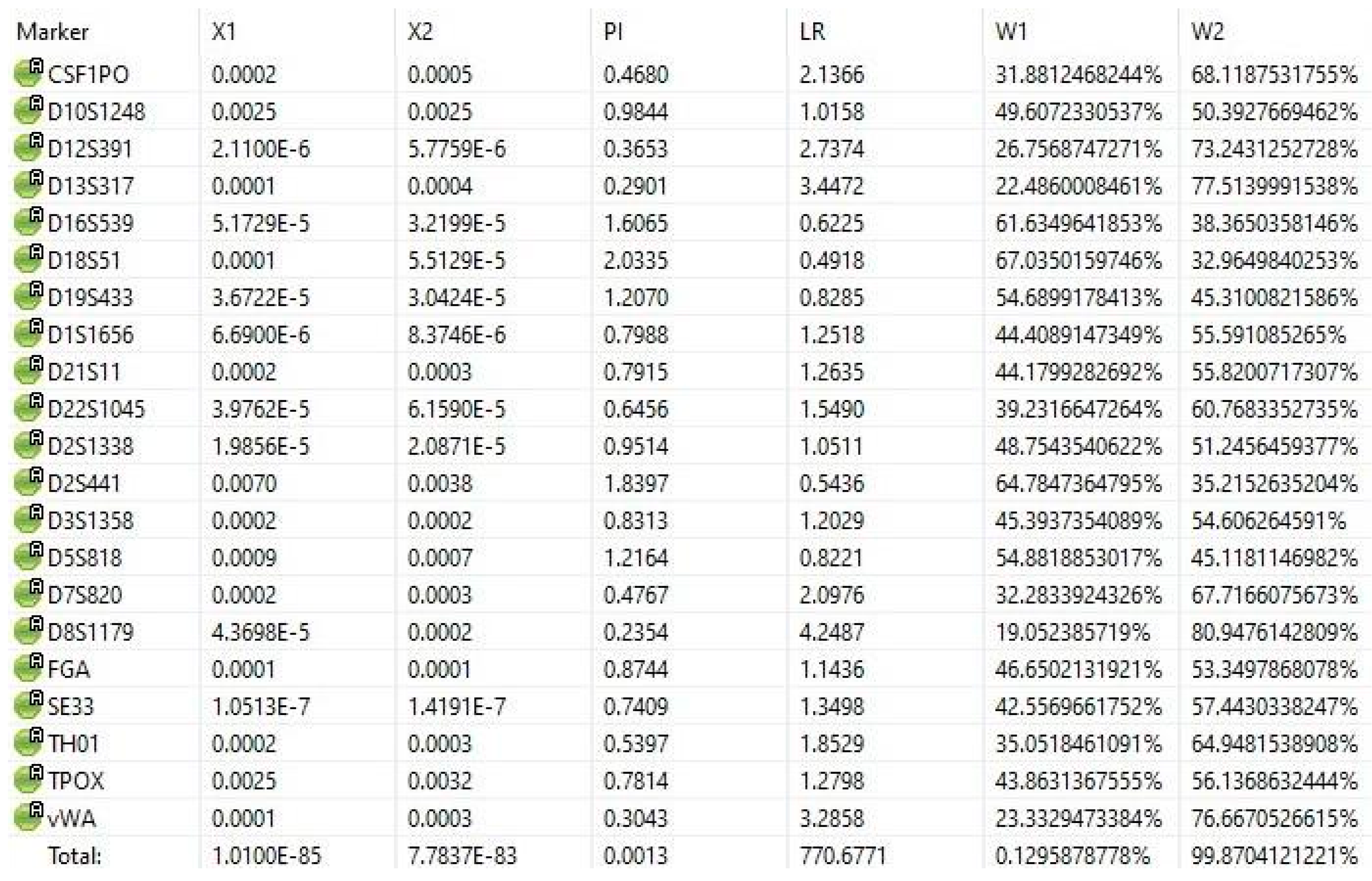
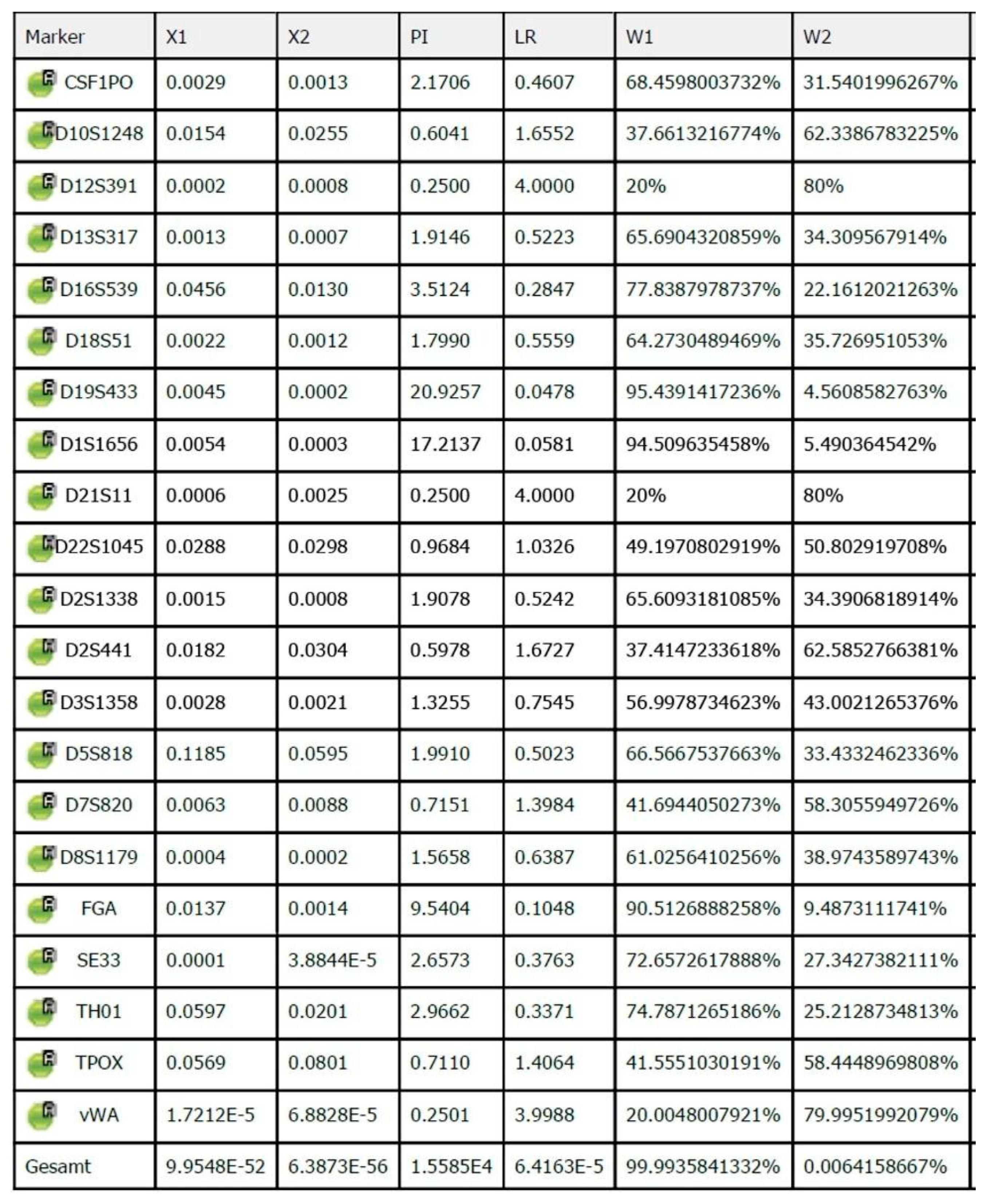
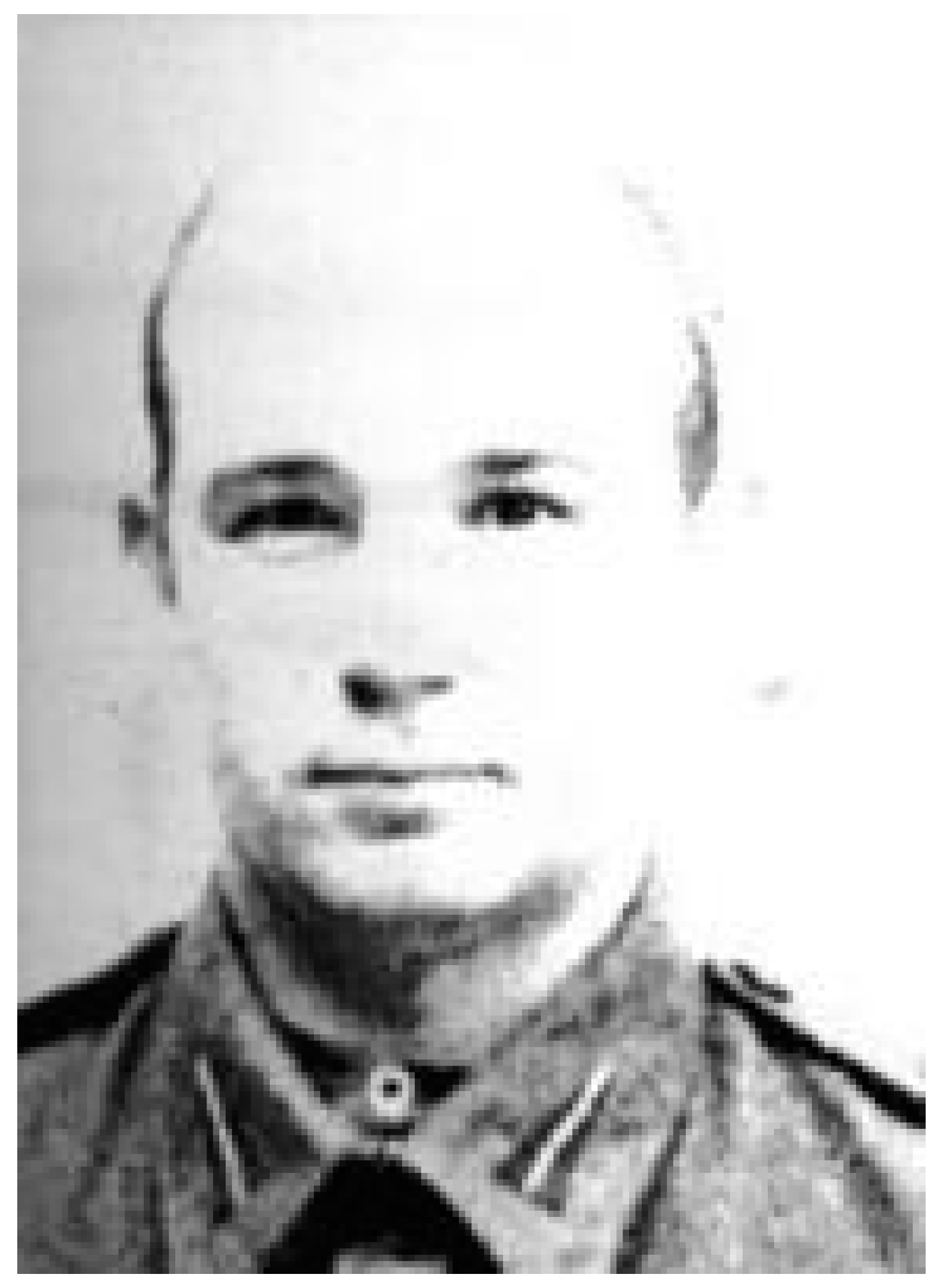
| Evidence Secured | DNA Concentration [ng/µL] | Presence of PCR Inhibitors |
|---|---|---|
| Fragment of the shaft of the right femur | 0.010 | not detected |
| Scala part of the right temporal bone | indefinable | not detected |
| Left maxillary tooth (M3 L) | 0.023 | not detected |
| Marker | P1 vs. D1 | P2 vs. D1 |
|---|---|---|
| DYS576 | C | C |
| DYS389I | C | C |
| DYS635 | C | C |
| DYS389II | x | x |
| DYS627 | x | x |
| DYS460 | C | C |
| DYS458 | x | x |
| DYS19 | x | x |
| Y GATAH4 | x | x |
| DYS448 | x | x |
| DYS391 | x | x |
| DYS456 | x | x |
| DYS390 | x | x |
| DYS438 | x | x |
| DYS392 | C | C |
| DYS518 | x | x |
| DYS570 | x | x |
| DYS437 | x | x |
| DYS385 | x | x |
| DYS449 | x | x |
| DYS393 | C | C |
| DYS439 | x | x |
| DYS481 | x | x |
| DYF387S1 | x | x |
| DYS533 | x | x |
| Marker | P3 vs. D1 |
|---|---|
| D3S1358 | C |
| vWA | x |
| D16S539 | C |
| CSF1PO | C |
| TPOX | C |
| D8S1179 | C |
| D21S11 | x |
| D18S51 | C |
| D2S441 | C |
| D19S433 | C |
| TH01 | C |
| FGA | C |
| D22S1045 | C |
| D5S818 | C |
| D13S317 | C |
| D7S820 | C |
| SE33 | C |
| D10S1248 | C |
| D1S1656 | C |
| D12S391 | x |
| D2S1338 | C |
| mtDNA Fragment | P3 vs. D1 |
|---|---|
| HV1 (16,024–16,365) | C |
| HV2 (73–340) | C + LH 303–310 |
Disclaimer/Publisher’s Note: The statements, opinions and data contained in all publications are solely those of the individual author(s) and contributor(s) and not of MDPI and/or the editor(s). MDPI and/or the editor(s) disclaim responsibility for any injury to people or property resulting from any ideas, methods, instructions or products referred to in the content. |
© 2023 by the authors. Licensee MDPI, Basel, Switzerland. This article is an open access article distributed under the terms and conditions of the Creative Commons Attribution (CC BY) license (https://creativecommons.org/licenses/by/4.0/).
Share and Cite
Lisman, D.; Bykowska, M.; Drath, J.; Zielińska, G.; Szargut, M.; Piątek, J.; Cytacka, S.; Dowejko, J.; Zacharczuk, J.; Ambroziak, J.; et al. Black Devils in Normandy—Identification of an Unknown Soldier Found in the Polish War Cemetery of Urville-Langannerie (France). Genes 2023, 14, 551. https://doi.org/10.3390/genes14030551
Lisman D, Bykowska M, Drath J, Zielińska G, Szargut M, Piątek J, Cytacka S, Dowejko J, Zacharczuk J, Ambroziak J, et al. Black Devils in Normandy—Identification of an Unknown Soldier Found in the Polish War Cemetery of Urville-Langannerie (France). Genes. 2023; 14(3):551. https://doi.org/10.3390/genes14030551
Chicago/Turabian StyleLisman, Dagmara, Milena Bykowska, Joanna Drath, Grażyna Zielińska, Maria Szargut, Jarosław Piątek, Sandra Cytacka, Joanna Dowejko, Julia Zacharczuk, Jan Ambroziak, and et al. 2023. "Black Devils in Normandy—Identification of an Unknown Soldier Found in the Polish War Cemetery of Urville-Langannerie (France)" Genes 14, no. 3: 551. https://doi.org/10.3390/genes14030551
APA StyleLisman, D., Bykowska, M., Drath, J., Zielińska, G., Szargut, M., Piątek, J., Cytacka, S., Dowejko, J., Zacharczuk, J., Ambroziak, J., & Ossowski, A. (2023). Black Devils in Normandy—Identification of an Unknown Soldier Found in the Polish War Cemetery of Urville-Langannerie (France). Genes, 14(3), 551. https://doi.org/10.3390/genes14030551






